NCERT Solutions for Class 10 Science Chapter 12 ElectricityIn this page, we'll provide you all the details you need about the NCERT solutions for electricity chapter 12 of class 10 science. Candidates will do better on both the in-class exams and the class 10 board exam if they practice these NCERT solutions. Electricity chapter of class 10 NCERT solutions can help students succeed in board exams as well as in other competitive exams. Furthermore, applicants may get numericals for electricity class 10 with solutions, which helps them complete their assignments. Continue reading to get more about NCERT Solutions For Class 10 Science Chapter 12 Electricity. NCERT Solutions for class 10 science Chapter 12 Inside Book QuestionsPage Number: 200Question 1: What does an electric circuit mean? Answer: An electric circuit is a closed path in which current flows. The circuit does not have any fixed length however it is controlled by a switch so that a person can control when the current should flow and when it should not. Question 2: Define the unit of current. Answer: The current is basically measured in Ampere which is its unit. A coulomb charge flowing through any part of the conductor in a second then the current passing through the section of the conductor is called as an ampere. 
Question 3: Calculate the number of electrons constituting one coulomb of charge. Answer: 1 coulomb of charge consists of 6.25 x 1018 electrons. Charge on an electron e is 1.6 x 10-19 C Net Charge Q = 1 C Thus, number of electrons in 1 C is, 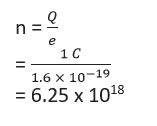
Page Number: 202Question 1: Name a device that helps to maintain a potential difference across a conductor. Answer: A battery is one such type of device that is used to maintain potential difference across a conductor. Question 2: What is meant by saying that the potential difference between two points is 1v? Answer: When we say that potential difference across two points is 1v, then we mean to say that, in moving 1 coulomb of electric charge from a point to other point 1 joule of work has been done. Question 3: How much energy is given to each coulomb of charge passing through a 6v battery ? Answer: Each coulomb of charge gets 6J of energy. Energy provided by the battery (W) = charge (Q) x potential difference (V) or, W = Q x V or, W = 1C x 6V = 6J Page Number: 209Question 1: On what factors does the resistance of a conductor depend? OR List the factors on which the resistance of a conductor in the shape of a wire depends. Answer: Resistance of the conductor are dependent on various factors and some of them are given below
Question 2: Will current flow more easily through a thick wire or a thin wire of the same material, when connected to the same source? Why? Answer: As we know that there is a thickness difference between the two wires which basically means that they differ in their area of cross section. So the current flow is dependent on the area of cross section of the conductor. Thick wire will allow the current to flow more easily because it has greater area and greater area enhances movement of electrons. Electrons are able to move freely which means that the resistance offered by thick wire is also less. So more the electrons are free to move, more will be the current flow through a conductor. Question 3: Let the resistance of an electrical component remains constant while the potential difference across the two ends of the component decreases to half of its former value. What change will occur in the current through it? Answer: If the potential difference is made half of its original value then the current flow will also get affected and it will also reduce to half of its original value. This can be understood by Ohm's law which states that V ∝ I. Question 4: Why are coils of electric toasters and electric irons are made of an-alloy rather than a pure metal? OR Why are alloys commonly used in electric heating devices? Given reason. Answer: There are various kinds of reasons because of which pure metal is not used to make coils of electric toasters and electric irons instead of it an alloy is used and the reasons are as follows:
Question 5: Use the data in Table 12.2 (in NCERT Book on Page No. 207) to answer the following :
Answer: The given data offers the resistivity of the three metals , mercury, iron and silver. i.) From the resistivity point of view we can say that between iron and mercury, one who offers low resistance will be good conductor of electricity because flow of electron will be in ease. Resistivity of the metals are: Iron = 10.0 x 10-8 Ω m Mercury = 94.0 x 10-8 Ω m 10.0 x 10-8 Ω m < 94.0 x 10-8 Ω m, hence conduction of electricity in iron will be better compared to mercury as it offers low resistance than mercury. ii.) Obviously the metal which provides the least resistivity will be the best conductor of electricity. Resistivity of the metals are: Iron = 10.0 x 10-8 Ω m Mercury = 94.0 x 10-8 Ω m Silver = 1.60 x 10-8 Ω m 1.60 x 10-8 Ω m < 10.0 x 10-8 Ω m < 94.0 x 10-8 Ω m, thus silver is the best conductor of electricity as it offers the lowest resistance than iron and mercury. Page Number: 213Question 1: Draw a schematic diagram of a circuit consisting of a battery of three cells of 2 V each, a 5Ω resistor, an 8 Ω resistor, and a 12 Ω resistor, and a plug key, all connected in series. Answer: The circuit diagram is shown below. 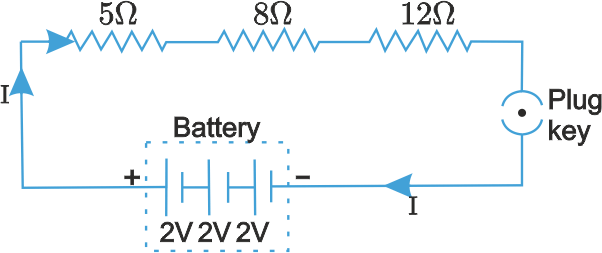
Question 2: Redraw the circuit of Questions 1, putting in an ammeter to measure the current through the resistors and a voltmeter to measure the potential difference across the 12 Ω resistor. What would be the readings in the ammeter and the voltmeter? Solution: The required circuit diagram is shown below. 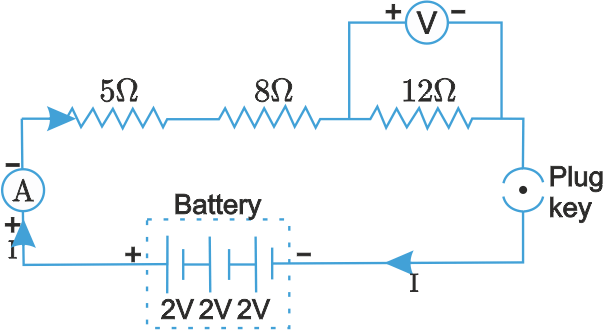

Page Number: 216Question 1: Judge the equivalent resistance when the following are connected in parallel :
Answer: The equivalent resistance is less than the smallest individual resistance when the resistances are connected in parallel.
Question 2: An electric lamp of 100 Ω, a toaster of resistance 50 Ω, and a water filter of resistance 500 Ω are connected in parallel to a 220 V source. What is the resistance of an electric iron connected to the same source that takes as much current as all three appliances, and what is the current through it ? Solution: Resistance of Objects are: R1 =Electric Lamp = 100 Ω R2 = Toaster = 50 Ω R3 = Water Filter = 500 Ω Equivalent resistance RP of the three appliances connected in parallel, is 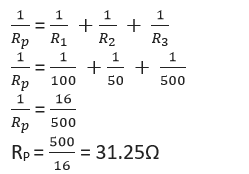
For second case it is given that the iron takes the same amount of current consumed by the above three appliances. So the resistance will also be the same. Voltage V = 220V 
Question 3: What are the advantages of connecting electrical devices in parallel with the battery instead of connecting them in series ? Answer: Connecting electrical devices in parallel have several advantages than connecting them in series and the advantages are discussed below.
Question 4: How can three resistors of resistances 2Ω, 3 Ω, and 6Ω be connected to give a total resistance of (i) 4 Ω, (ii) 1 Ω? Solution: i.) By joining the 2Ω resistance in series with the parallel combination of 3Ω and 6Ω, we may obtain a total resistance of 4Ω. 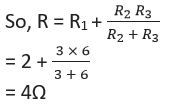
ii.) By connecting resistors of 2Ω, 3Ω, and 6Ω in parallel, we may get a total resistance of 1Ω. 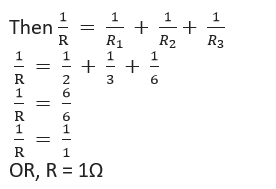
Question 5: What is (i) the highest, (ii) the lowest total resistance that can be secured by combinations of four coils of resistance 4 Ω, 8 Ω, 12 Ω, 24 Ω? Solution: i.) The four coils can be connected in series to get the highest resistance. Then, R = 4Ω + 8Ω + 12Ω + 24Ω = 48Ω ii.) The four coils can be connected in parallel to get the lowest resistance. 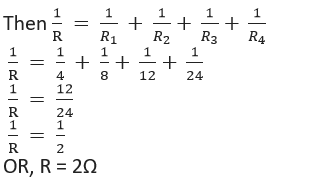
Page Number: 218Question 1: Why does the cord of an electric heater not glow while the heating element does? Solution: The amount of heat generated in a circuit is determined by I2R t. Contrary to the heating element of an electric heater made of nichrome, which glows because it becomes red-hot due to the significant amount of heat produced on passing current because of its high resistance, the cord of an electric heater made of copper does not glow because very little heat is produced in it by passing current because of its extremely low resistance. Question 2: Compute the heat generated while transferring 96000 coulomb of charge in one hour through a potential difference of 50 V. Solution: Here, Q = 96,000 C t = 1 hour = 1 x 60 x 60 sec = 3600s V = 50 V Heat generated, H = VQ = 50V x 96,000 C = 48,00,000 J = 4.8 x 106 J Question 3: An electric iron of resistance 20Ω takes a current of 5 A. Calculate the heat developed in 30 s. Solution: Here, R = 20 Ω i = 5 A t = 3s Heat developed, H = I2R t = 25 x 20 x 30 = 15,000 J = 1.5 x 104 J Page Number: 220Question 1: What determines the rate at which energy is delivered by a current ? Answer: The circuit's resistance controls how quickly a current can transfer energy. Question 2: An electric motor takes 5 A from a 220 V line. Determine the power of the motor and the energy consumed in 2 h. Answer: Here, I = 5 A V = 220 V t = 2h = 7,200 s Power, P = V I = 220 x 5 = 1100 W Energy consumed = P x t = 100 W x 7200 s = 7,20,000 J = 7.2 x 105 J NCERT Solutions for class 10 science Chapter 12 Inside Book QuestionsQuestion 1: A piece of wire of resistance R is cut into five equal parts. These parts are then connected in parallel. If the equivalent resistance of this combination is R', then the ratio R/R' is : 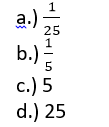
Answer: d.) 25 Explanation: After cutting resistance in each part 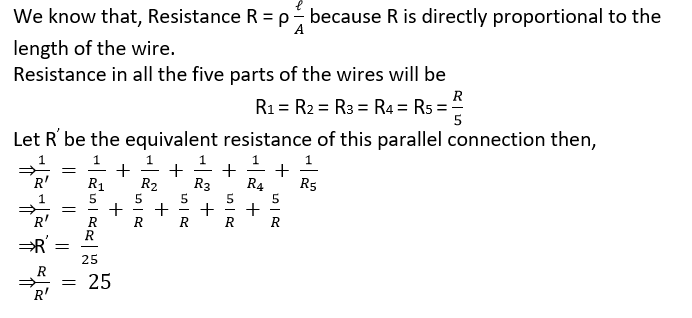
Question 2: Which of the following terms does not represent electrical power in a circuit? 
Answer: a.) IR2 Question 3: An electric bulb is rated 220 V and 100 W. When it is operated on 110 V, the power consumed will be :
Answer: d.) 25 W Explanation: Resistance of the given bulb is, Rating of bulbs P=100W, V=220V 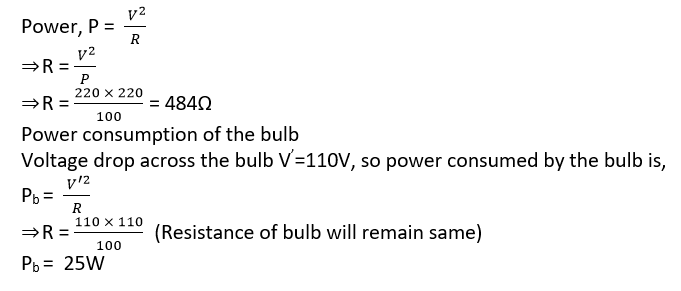
Question 4: Two conducting wires of the same material and of equal lengths and equal diameters are first connected in series and then parallel in a circuit across the same potential difference. The ratio of heat produced in series and parallel combinations would be :
Answer: c.) 1 : 4 Question 5: How is a voltmeter connected in the circuit to measure the potential difference between two points? Answer: To determine the potential difference between two points, a voltmeter is connected in parallel. Question 6: A copper wire has diameter 0.5 mm and resistivity of 1.6 x 10-8 Ω m. What will be the length of this wire to make its resistance 10 Ω ? How much does the resistance change if the diameter is doubled? Answer: 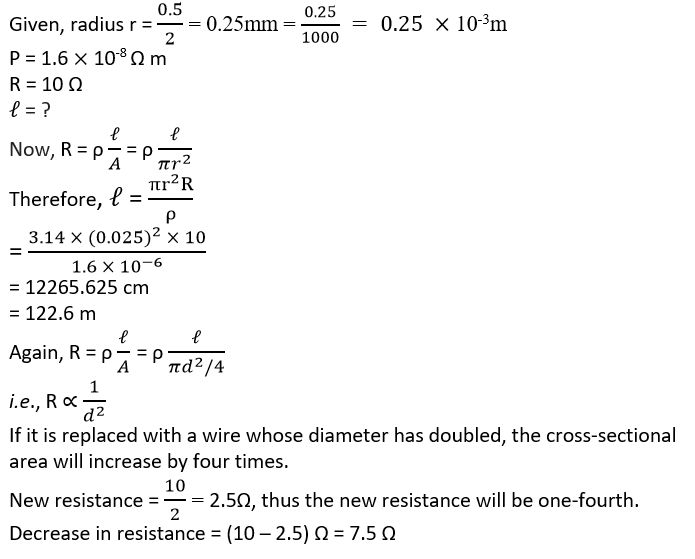
Question 7: The values of current I flowing in a given resistor for the corresponding values of potential difference V across the resistor are given below :
Plot a graph between V and I and calculate the resistance of the resistor. Solution: The graph of above data between V and I is presented below. Resistance will be calculated from slope of the graph. Consider two points P and Q on the given graph and also a point R from P along Y-axis. Now, QR = 10.2V - 34V = 6.8V And PR = 3 - 1 = 2 ampere 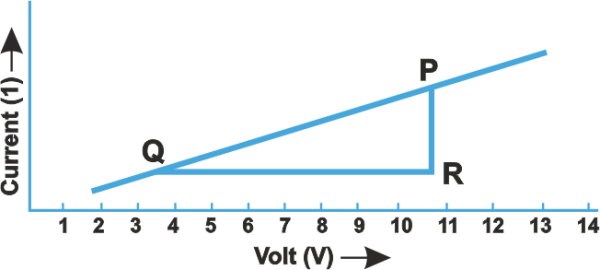
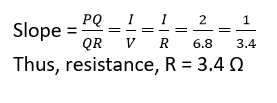
Question 8: When a 12 V battery is connected across an unknown resistor, there is a current of 2.5 mA in the circuit. Find the value of the resistance of the resistor. Solution: Given, V = 12V I = 2.5mA = 2.5 x 10-3 A Thus, Resistance is given by, 
Question 9: A battery of 9V is connected in series with resistors of 0.2Ω, 0.3Ω, 0.4Ω, 0.5Ω and 12Ω, respectively. How much current would flow through the 12Ω resistor? Solution: Total resistance, R = 0.2Ω + 0.3Ω + 0.4Ω + 0.5Ω + 12Ω = 13.4Ω Potential difference, V = 9V Current through the circuit in series is, 
Also the current is not divided in the circuit as a result of which 0.67A will be the current flowing through 12Ω resistor. Question 10: How many 176Ω resistors (in parallel) are required to carry 5A on a 220V line? Solution: Let us consider that there are n resistors of 176Ω connected in parallel. 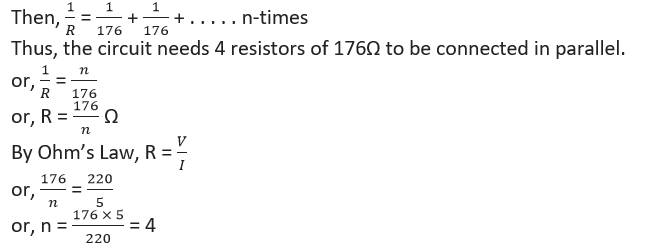
Question 11: Show how you would connect three resistors, each of resistance 6Ω, so that the combination has a resistance of (i) 9Ω, (ii) 4Ω Solution: Given, R1 = R2 = R3 = 6Ω. i.) If R1 is connected in series with the parallel combination of R2 and R3 as shown in Fig. (a). The equivalent resistance is, 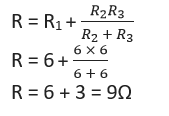
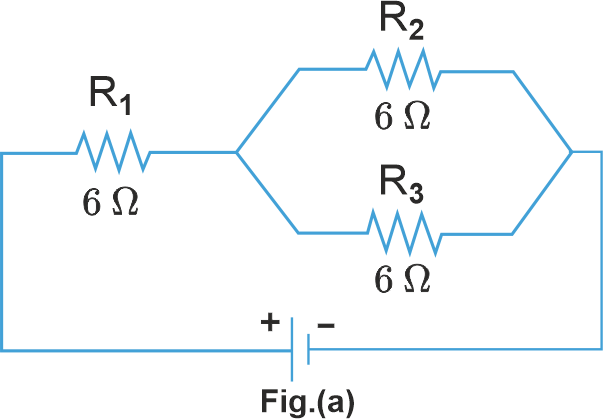
ii.) When we connect a series combination of R1 and R2 in parallel with R3, as shown in Fig. (b), The equivalent resistance is, 
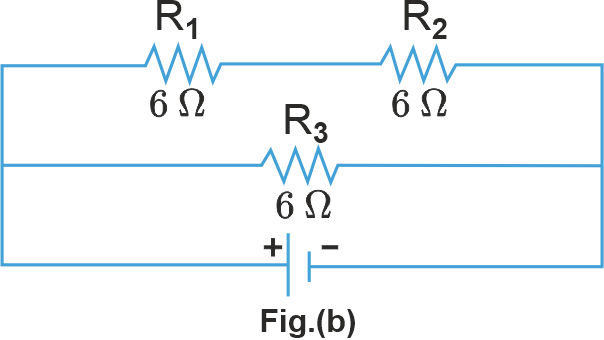
Question 12: Several electric bulbs designed to be used on a 220V electric supply line, are rated 10W. How many lamps can be connected in parallel with each other across the two wires of 220V line if the maximum allowable current is 5A? Solution: Given, Current, I = 5A Voltage, V = 220V 
Question 13: A hot plate of an electric oven connected to a 220V line has two resistance coils A and B, each of 24Ω resistance, which may be used separately, in series, or in parallel. What are the currents in the three cases? Solution: 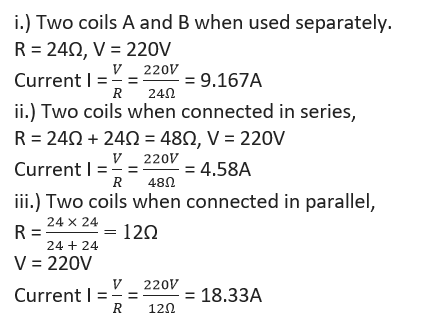
Question 14: Compare the power used in the 2Ω resistor in each of the following circuits
Solution: i.) The circuit diagram for first case is shown in the figure below. Total resistance, R = 1Ω + 2Ω = 3Ω Potential difference, V = 6V 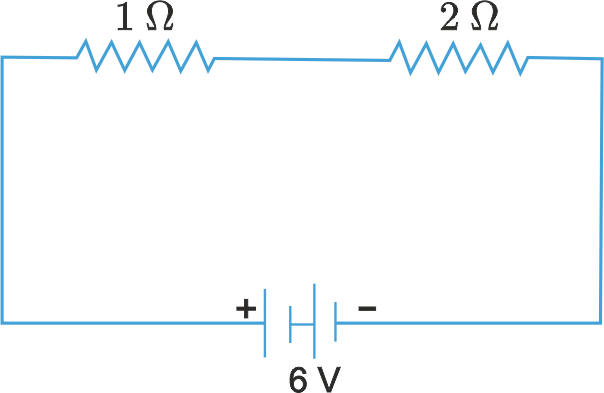
Power used in 2Ω resistor = I2R = (2)2 x 2 = 8W ii.) The circuit diagram for second case is shown below. 
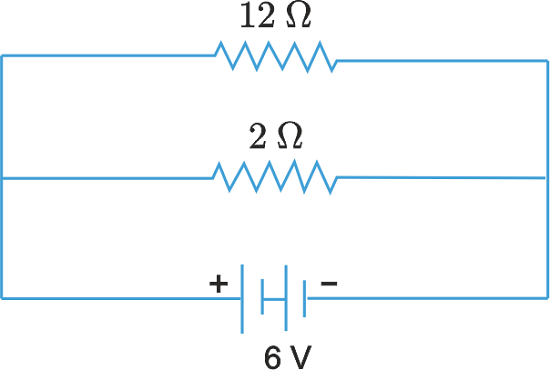
Various resistors used in parallel combinations have different currents. Question 15: Two lamps, one rated 100W at 220V, and the other 60W at 220V, are connected in parallel to electric mains supply. What current is drawn from the line if the supply voltage is 220V? Solution: Given, Power of first lamp (P1) = 100W Potential difference (V) = 220V Image Required 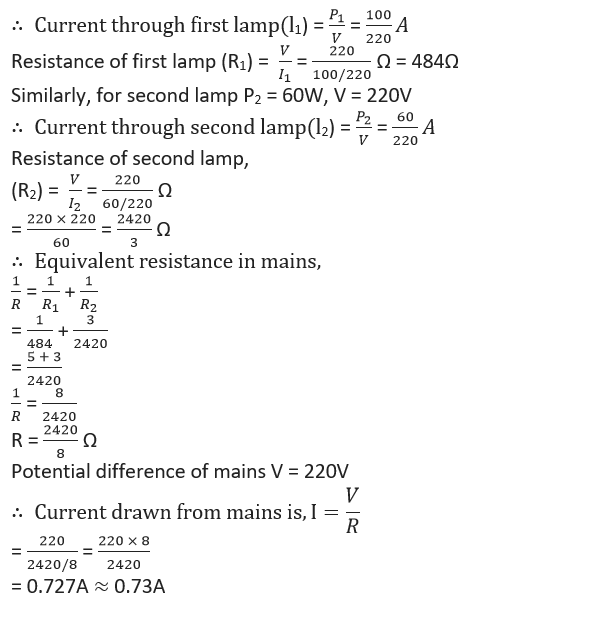
Question 16: Which uses more energy, a 250W TV set in 1 hr, or a 1200W toaster in 10 minutes? Solution: Energy used by 250W TV set in 1 hour is = 250W x 1 h = 250Wh Energy used by 1200W toaster in 10 minutes is = 1200 W x 10 min = 1200 x 10/60 = 200Wh Since 250 > 200, hence we can conclude that the TV will consume more energy. Question 17: An electric heater of resistance 8 Ω draws 15 A from the service mains 2 hours. Calculate the rate at which heat is developed in the heater. Solution: Here, R = 8Ω, I = 15A, t = 2h Heat is produced in the heater at a rate equal to its power. Thus, P = I2R = (15)2 times; 8 = 1800Js-1 Question 18: Explain the following:
Answer:
Next TopicClass 10 Science Chapter 13
|
 For Videos Join Our Youtube Channel: Join Now
For Videos Join Our Youtube Channel: Join Now
Feedback
- Send your Feedback to [email protected]
Help Others, Please Share









